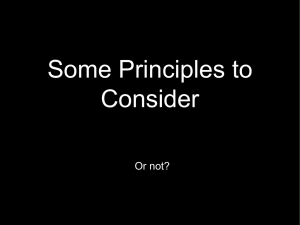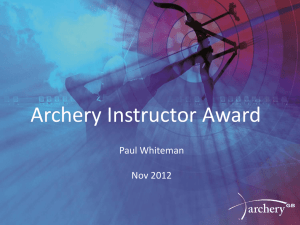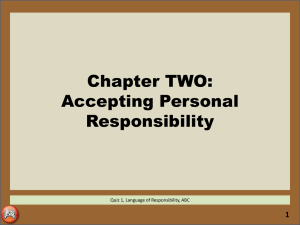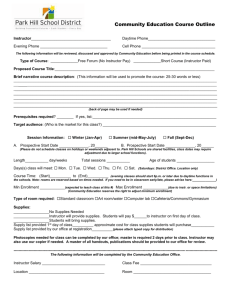PEER OBSERVATION & COACHING WORKSHOP
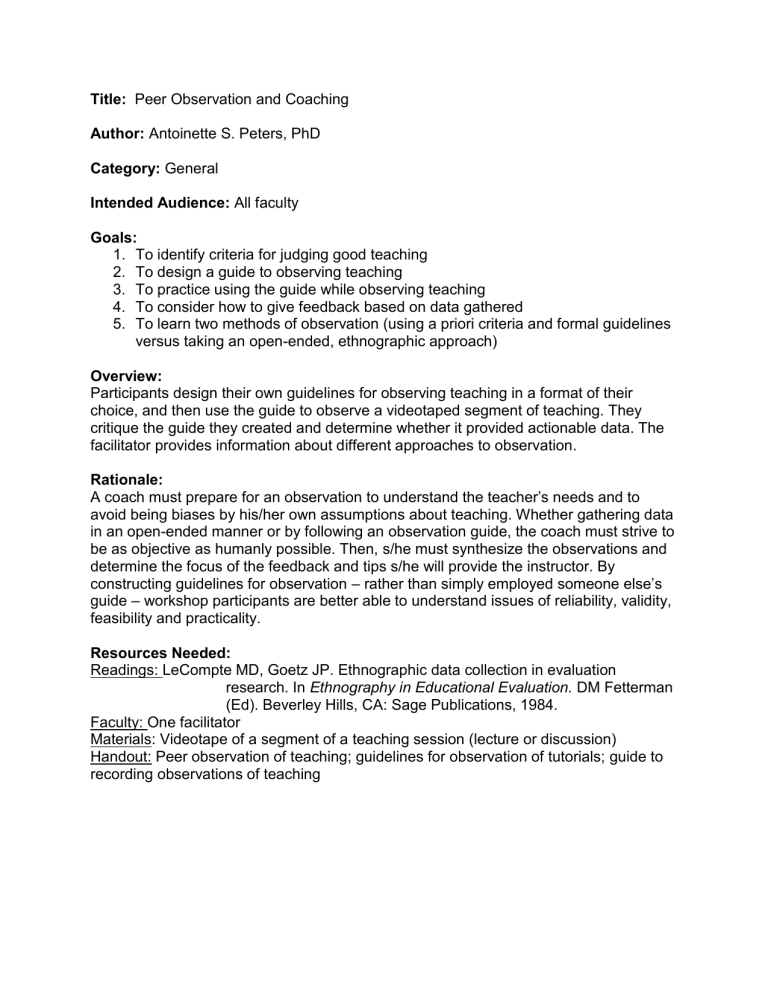
Title: Peer Observation and Coaching
Author: Antoinette S. Peters, PhD
Category: General
Intended Audience: All faculty
Goals:
1. To identify criteria for judging good teaching
2. To design a guide to observing teaching
3. To practice using the guide while observing teaching
4. To consider how to give feedback based on data gathered
5. To learn two methods of observation (using a priori criteria and formal guidelines versus taking an open-ended, ethnographic approach)
Overview:
Participants design their own guidelines for observing teaching in a format of their choice, and then use the guide to observe a videotaped segment of teaching. They critique the guide they created and determine whether it provided actionable data. The facilitator provides information about different approaches to observation.
Rationale:
A coach must prepare for an observation to understand the teacher’s needs and to avoid being biases by his/her own assumptions about teaching. Whether gathering data in an open-ended manner or by following an observation guide, the coach must strive to be as objective as humanly possible. Then, s/he must synthesize the observations and determine the focus of the feedback and tips s/he will provide the instructor. By constructing guidelines for observation – rather than simply employed someone else’s guide – workshop participants are better able to understand issues of reliability, validity, feasibility and practicality.
Resources Needed:
Readings: LeCompte MD, Goetz JP. Ethnographic data collection in evaluation research. In Ethnography in Educational Evaluation. DM Fetterman
(Ed). Beverley Hills, CA: Sage Publications, 1984.
Faculty: One facilitator
Materials: Videotape of a segment of a teaching session (lecture or discussion)
Handout: Peer observation of teaching; guidelines for observation of tutorials; guide to recording observations of teaching
Protocol (90 minutes)
Introductions (10 minutes) Participants state their names, teaching methods they use most frequently, responsibility for coaching others, and prior experience as coaches.
The facilitator determines the focus for the workshop (generic observation and coaching versus observation of one format). S/he then states the goals of the session, incorporating input from the participants (i.e., what they would like to learn to do).
Orientation to good teaching (20 minutes) The facilitator leads a discussion, asking the following questions:
Are there universal criteria for good teaching? o If the group is interested in one format, the facilitator asks: What makes a good lecturer good? A good tutor good? Etc.
Can one observe these aspects of good teaching? If so, o What would one look at or for? o What kind of data would be generated?
The facilitator describes different approaches to gathering data. For example, one might enter a classroom with no a priori questions, and then use an ethnographic approach of looking at the action: what the teacher is doing and how learners respond. At first, the observer gets a general impression of the situation and then carefully records what s/he hears and sees, later debriefing with learners and teachers. Alternatively, the observer enters the classroom with a question, perhaps generated by a complaint from learners.
In this case, the observer looks for certain kinds of behaviors, but again records data as objectively as possible. The facilitator briefly demonstrates how one maps the topography of the classroom (e.g., where the teacher sits or stands) and records both quasi-objective data and personal impressions and reactions (handout).
Creation of an observation guide (15 minutes) Referring to the questions above, the group breaks into triads to design an observation guide that one might use to look for a particular kind of behavior. They consider reliability (their own biases and assumptions); feasibility of data gathering (number of things they can observe in the time given); sufficiency of data or whether they might triangulate the observations with other data such as interviews with learners or others; and validity (whether the data align with the institution’s evaluation data). They also consider how the data will be useful to the instructor – i.e., actionable.
Application of the tool (20 minutes) The group observes a videotaped clip of teaching, each triad using its own tool as a guide to observation (approximately 5 minutes). The mini-groups compare notes briefly, and then the facilitator asks:
How much could you observe?
What kinds of notes did you take?
Do your observations agree with those of others?
What does this tell you about bias, about the criteria, about ways to record data?
What would you add or subtract from the guide?
Preparing feedback: (10 minutes) The facilitator then asks the group: What aspect of the teaching will you give feedback on? What tips will you give? What do you expect to happen?
Summary (10 minutes) The facilitator summarizes lessons learned, emphasizing that the goal is a practical one – namely, to help a teacher improve his/her teaching – but observations must be fair (reliable, valid, data-based, as unbiased as possible) and feedback, with tips, must be limited so the teacher can take action quickly. S/he then describes a possible step-by-step protocol coaches might follow to be most effective
(handout).
HANDOUT
PEER OBSERVATION OF TEACHING
There is no more powerful way to teach anyone a skill than one-on-one coaching with feedback.
Peer coaching in teaching – which entails careful and focused observation of a performance, followed by feedback and guidance
– is especially valuable when the peer is a trusted colleague who shares one’s body of knowledge and general philosophy of teaching. No matter what the format for teaching, the following guidelines pertain.
Step #1. Establish a need . The instructor may have received students’ ratings of her teaching and want to respond to one of their criticisms. Or, she may feel insecure about a new way of teaching or one aspect of her teaching. To the extent that she can identify what she hopes to improve, and what the coach should observe and provide feedback about, the endeavor has a high probability of success.
Step #2. Establish a relationship. The instructor and the coach should have a frank conversation about confidentiality and the use of data collected during the observation. The instructor may want feedback simply to increase his satisfaction with teaching, or he may want information to contribute to a promotion portfolio. No matter what the purpose, the coach must be trustworthy.
Step #3. Agree upon the logistics of the session. The coach should be aware of the level of learner, the instructional format and the goals of the session. The instructor must request permission from learners and anyone else present (e.g., patients) to introduce the observer, helping them to understand the role of the coach and how the observation will affect them.
Step #4. Prepare an observation guide. The coach cannot observe – or at least record – everything that occurs during the session; and the instructor cannot change more than one or two aspects of his teaching all at once. Therefore, the observation guide should be designed to focus on an aspect of performance in the designated instructional format. It might be desirable to design a guide that parallels the criteria learners use to rate the instructor’s performance.
Standard forms should be used parsimoniously.
Step #5. Observe the instructor. Data should be as objective as possible. This requires the observer to record exact behaviors and quotes rather than her impressions. While the instructor will be nefit from a trusted peer’s impressions, he will have more confidence in these impressions if the coach bases them on data. For example, the coach may provide data on the frequency with which an instructor asked open ended questions or the length of time an instructor waited until a student answered a question; or he might quote exactly what an instructor said so that together they may evaluate tone.
Step #6. Provide feedback and tips for improvement. The coach and instructor should both reflect on the session and organize their observations and impressions prior to discussing it together. It is useful to allow the instructor to begin the discussion by stating whether the session was a typical representation of his performance, what he thought went well and what he thinks needs to be improved in relation to the area he identified prior to the observation. The coach may begin feedback in response to these concerns. Plans for next steps should be limited and focused.
Step #7. Follow up. After taking the coa ch’s tips and some practice, the instructor should ask the coach to revisit a session to observe and provide further feedback.
GUIDELINES FOR OBSERVATION OF TUTORIALS
There are common problems that occur in any task-oriented small group: uneven participation
(dominating by some, hanging back by others), tensions and struggles when the task is difficult; competitiveness for external validation; lack of preparation prior to meeting; lack of focus; excessive social interchange; etc. Moreover, in PBL tutorials, there is a delicate balance between tutors’ saying too much and saying too little. The following guidelines have been composed with these typical problems in mind.
When observing small group teaching, there is much to see and to comment upon. Therefore, it helps to take one of two tacks: either plan to observe more than once and use the first session to gain a general impression of how the group is working, or, if you have only one opportunity to observe, identify a focus in collaboration with the tutor. S/he may have an idea of an existing problem amongst group members or may be struggling with her/his own facilitation skills. Given the fact that no one can change too many behaviors at once, you will do much good simply focusing on one problem and providing honest and constructive feedback on your observation.
Group Formation:
1. Do group members check in with one another socially at the beginning of the session?
Does it feel like a friendly and caring group?
2. Do group members, with or without the tutor’s guidance, organize a plan of action within the first few minutes of the meeting?
3. Does the tutor check in with students both socially and in regards to their task?
Task Performance – Information and Responsibility Sharing:
1. Is there evidence that students have worked on the task between meetings? a. Did they read? b. Did they organize materials/information for presentation? c. Did they work together outside class?
2. Do students bring information to the group to share?
3. Do students explain ideas in depth and provide supporting evidence?
4. Do students disagree with one another? Are disagreements productive?
5. Did the tutor bring information s/he may have promised to bring?
6. Does the tutor provide information appropriately? a. Does s/he lecture? b. Does s/he provide basic facts as a time-saving strategy? c. Does s/he bring in clinical applications?
7. Who controls the white board and the plasma screen?
8. Does the tutor take or miss opportunities to probe students’ reasoning?
9. Does the tutor ask open-ended questions?
10. Does the tutor give students enough time to respond to questions?
Social Cohesion:
1. Are disagreements task-oriented or personal?
2. Do students resolve conflicts before leaving class?
3. Does the tutor ask students to stop to examine their interaction critically?
4. Does the tutor ask students how the group could work more effectively together?
5. Does the tutor ask students to give him/her feedback or suggestions on how to improve?
GUIDE TO RECORDING OPEN-ENDED OBSERVATIONS OF TEACHING
Step 1 . Establish a log of your observations in which you record information such as
Date/Time/Location
Course name/ Topic for the day
Instructional format
Instructor’s name
Step 2.
Map the environment on a page separate from your recorded observations. You may want to refer to this map as you record. If you are observing a small group, number the students and locate the instructor, such as you see on the diagram below. This will serve as a shorthand should you choose to record individuals’ behavior. You can map large group or clinical teaching environments, though numbering students in a lecture hall may be prohibitive.
Sample Map of Classroom for Small Group Discussion
Entry/Exit
Student 1 -
Male
S2
White Board
– Female S3 – Female S4 - Female work table w/ books, notebooks, plasma screen controls, laptops, food
Student ID Instructor Student ID Student ID
Plasma Screen and 2 nd White Board
S5 – Male
Step 3 . Open a notebook and set up two facing pages using the following format. On the lefthand page, you will record your observations and your immediate reactions. Use the right-hand page later when you have an opportunity to reflect upon what you saw and how you reacted to it. An example of an observation record is provided.
NOTEBOOK FORMAT
Observation
Left-hand Page
Observation
Left-hand Page
S1 → S5: What you said earlier about everyone but me being a genius really hurt my feelings.
S5: I’m sorry. I was totally joking.
Ss 2 & 6 working at board…..
Reaction Assumption
Right-hand Page
Question
SAMPLE NOTEBOOK
Reaction Assumption
Right-hand Page
Question
Good for her!
Where’s the tutor?
Why didn’t he do anything?
I believe tutors should facilitate good group interaction.
Do effective tutors allow students to work things out for themselves or do they intervene?
Step 4. Observe the class. Make every attempt to be objective. Quote as accurately as possible. Avoid confusing your reactions with data collection. Compare the following two notes: a. The tutor was so embarrassed he avoided looking at the students. b. During this interchange, the tutor paged through a book.
You do not know what the tutor was feeling until you ask him. Statement A interjects your own feelings and may bias your observation. Statement B is more factual. You should, however, make note that you were wondering whether the tutor was feeling embarrassed, and then explore this issue later if it continues to be important to you.
Step 5 . Follow up by reflecting upon what you observed and exploring your own reactions. It is difficult for all of us to identify our own biases or assumptions, so discussing observations and reactions with a colleague often helps. One method ethnographers use is to interview some of the people one has observed and to ask them to explain what the interaction meant to them. For instance, in the example above, you might ask the tutor what he was thinking or feeling during an episode of “teasing” and what he thought of the resolution of the situation. Again, it is important to avoid bias; frame your questions carefully.
Once you can identify your underlying assumptions about what you observed, determine how you would like to proceed to test your assumption. This last step might entail writing an hypothesis or testable research question, or designing a piece of teaching during which you will try out a new method.


